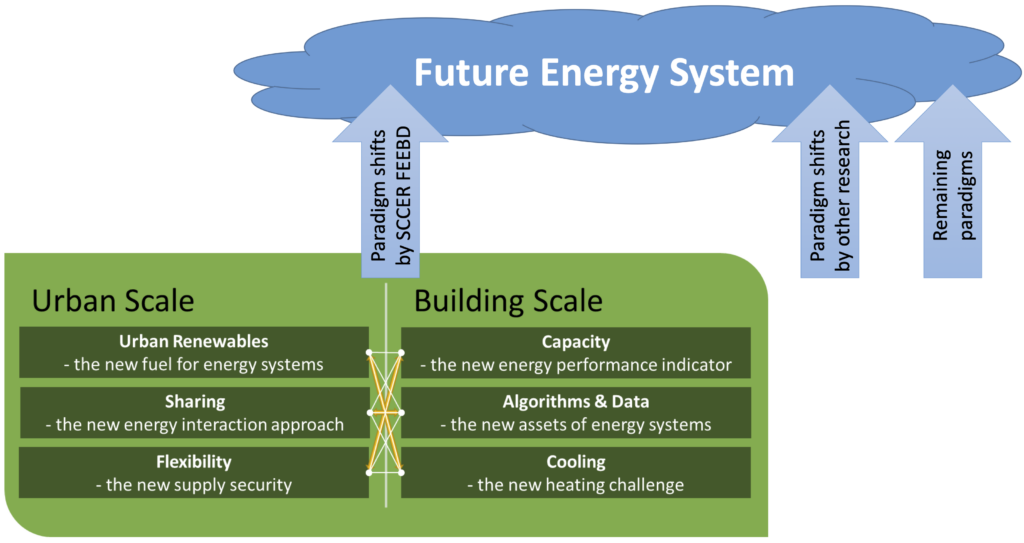
Data exchange via virtual assistants is key to unlocking the full potential of the future energy system
On 01.10.2020 by Matthias SulzerProf. Matthias Sulzer is the head of the Swiss Competence Center for Energy Research – Buildings and Districts (SCCER-FEEBD) at Empa and teaches at ETH Zurich and Lucerne University of Applied Sciences and Arts. He also holds a research appointment at Lawrence Berkeley National Laboratory in the US. Matthias Sulzer studied building engineering at Lucerne University of Applied Sciences and completed his master’s degree at the Universities of New South Wales and Sydney in 1999. He founded Inretis Holding AG with two partners in 2005. In 2018 he merged with poenina holding AG. Today, the listed company with over 1,400 employees is active in the field of energy and building technology as well as building envelopes.
Connecting buildings to a cross-sectoral, decentralized energy system is a proven means of integrating more renewable energy sources and further increasing energy efficiency. However, the operation of such highly interconnected energy systems is becoming painstaking. Data and algorithms will be the key to overcome these pains and to unlock the innovative systems’ full potential.
In order to achieve the climate goal of net-zero greenhouse gas emissions in 2050, there is an urgent need to transform the current energy system. Today’s concepts are often based on a top-down approach with an omniscient technical blueprint to integrate renewable energy sources like wind, water, solar, geothermal, and biomass while reinforcing the electrical grid. Although, a bottom-up approach is also becoming promising in increasing the resilience of the energy system. Decentralized energy systems increase self-sufficiency or the involvement of consumers improve the adaptability and flexibility of the energy system. In short, subsystems at local, neighborhood-level offer new opportunities, but also increase the complexity, especially in operation.
To set the right course in addressing the challenges of decentralized energy systems, the Swiss Competence Center for Energy Research in Buildings and Districts, SCCER FEEB&D, has identified six paradigm shifts that relate to solutions supporting the transformation of the building stock and current energy system towards net-zero emissions. The identified paradigm shifts are not exhaustive, but are embedded seamlessly in further paradigm shifts from other research or in remaining paradigm shifts (Fig 1).

As a core finding, we identified that sharing of infrastructure, technology and data is vital for the energy transition. In order to share technology, but also renewable sources, buildings must be connected to infrastructures, such as district heating and cooling networks and microgrids. Integrating different technologies and energy carriers creates space for the development of decentralized energy systems (Fig 2). With such local energy systems, renewable energy sources and energy demand can be managed efficiently, due to the spatially close interconnections. Expensive technologies can be shared, thus allowing economically attractive systems to be built and operated. Sharing also refers to an effective integration of local energy systems into the broader regional or national energy supply, such as electricity and gas networks. In order to operate the future CO2-free energy system in a reliable, economical and environmentally-friendly manner, the operational tasks at every system level from the scale of buildings, cities, and nations, must be redefined.

So far so good, but sharing increases the complexity of the energy system. If different technologies are combined, an interacting system is created, which not only exchanges energy but also information. The additional interconnections require more information to master the design and particularly the operation. Data and algorithms are the key to unlock the full potential of such complex systems. Virtual assistants are needed to foster the continuous exchange of information. They ensure that the energy supply is continuously adapted to the needs of the consumers, but also to the availability of renewable energy.
Connections enable the transition but require trust
My first conclusion: Sharing needs information. The more comprehensively decentralized energy systems are built, the more information needs to be shared. Hence, the interconnections in the physical, urban space must be reflected in the virtual, digital space. The digital layer of decentralized energy systems will ensure that the interacting technologies can be operated efficiently and effectively as a holistic system. But, do homeowners and occupants want to connect their homes more intensively, exchanging both data and energy?
In order to achieve a high level of acceptance among participants for decentralized energy systems, three conditions and two prerequisites must be met. The three conditions are (i) unconditional compliance with privacy along with ensuring both (ii) data and (iii) energy supply security. On this basis, a trustful environment can be created that allows effective sharing of data and energy.
To ensure an intensive exchange of data and energy, the first prerequisite must establish that sharing is beneficial. The benefit can be monetary and non-monetary. Non-monetary advantages are, for example, the supply of local renewable energy, CO₂-free operation of the buildings, or access to other services such as car sharing.
The second prerequisite to establish is the effortless and enjoyable participation in the decentralized energy system. The energy business is a penny business. Hundreds and thousands of decisions have to be made every day, in order to maximize economic, environmental and user benefits. But the monetary value of each transaction is very small. Moreover, the transactions are often highly repeatable. It is unimaginable that users actively participate in such a business, constantly communicating decisions based on their behavior or preferences to the local energy system’s operator.
Virtual assistants play a role in user-centric system optimization
My second conclusion: Participants in decentralized energy systems will be represented by their virtual assistants. Virtual assistants are digital representatives who handle all transactions necessary to operate the energy system according to the owners’ specified preferences. These digital assistants are continuously involved in the decision-making process to e.g., maximize the use of renewable energy, stabilize grids, minimize costs, or adjust comfort levels when not present. Such decisions generate only small returns, hence, the effort and transaction costs to make these decisions need to be minimal.

Digital assistants have the potential to sweeten our lives. Digital assistants, such as electronic stability control, start/stop systems, lane assist, adaptive cruise control, etc., enable us to enjoy driving a car in a safe and efficient way. Similarly, virtual assistants should enable us to participate in decentralized systems in a pleasurable and carefree way.
Digital innovations in the energy sector are necessary to build an effective digital layer for the future energy system. Energy research must further develop concepts such as Agent-Based Modeling, Perception Based Modeling and Urban Informatics in order to represent urban space and its occupants holistically in digital space (Fig. 3).
The government, in turn, must set boundary conditions and take over their duties in digital space, as it does in earthly space. Today, we are operating in digital space, as in the Wild West of over two centuries; You have to care for safety, security and trust yourself. Or, with reference to the digital world, you have to worry about setting up firewalls, hacker protection, phishing filters, fraudsters defense, etc. In the future, homeowners and users should feel comfortable moving, managing and enjoying themselves in digital space, as they do in today’s cities without armors and weapons. Their virtual assistants will support them if the business is small in scope, boring and/or repetitive. If we create such a digital environment, many obstacles for the deployment of decentralized energy systems are eliminated.
Keep up with the Energy Blog @ ETH Zurich on Twitter @eth_energy_blog.
Suggested citation: Sulzer, Matthias. “Data exchange via virtual assistants is key to unlocking the full potential of the future energy system”, Energy Blog @ ETH Zurich, ETH Zurich, September 30, 2020, https://blogs.ethz.ch/energy/data-exchange-via-virtual-assistants/
If you are part of ETH Zurich, we invite you to contribute with your findings and your opinions to make this space a dynamic and relevant outlet for energy insights and debates. Find out how you can contribute and contact the editorial team here to pitch an article idea!


A very attractive vision of the future – but a vision which is still far from what we have today. I believe that a lot of ingredients on the technical side are already here but there is a lot missing in our way how we approach the future of energy in practice.
Is information the bottleneck of the future energy system in Switzerland, as claimed in this article? I doubt it. Rather, it will be electricity and heating energy in winter, because electricity from solar energy and hydropower will be the future suppliers of electricity and energy, and since the sun shines very little in winter, a lot of electricity will have to come from energy storage facilities. The question will be thus: Can we produce in the winter the electricity which we need then for the heat pumps, the electric cars and the whole remainder. Batteries and reservoirs alone will not suffice as storage facilities, but stored hydrogen – or, in a less decentralized energy system, the guaranteed flow of electricity from the European grid – will probably also be needed.
The exchange of information from decentralized systems can also help – especially when it comes to saving in times of shortage.
Many thanks for the comment. Your analysis is spot-on. But the question arises, why are such decentralized solutions not implemented? The technology is available and so is the potential for cost reduction. In my opinion, there is a lack of information that would allow the market diffusion of such technologies and solutions on a large scale.